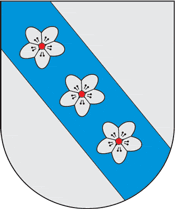 Alternate names: Obeliai [Lith], Abel [Yid], Abeli [Rus], Abele [Pol], Abeil, Abeliai, Obel, Russian: Абели. אַבעל-Yiddish. 55°56' N, 25°48' E, 9 miles E of Rokiškis, 22 miles NW of Zarasai. 1900 Jewish population: 652. Yizkors: Yisker-bukh fun Rakishok un umgegnt (Johannesburg, 1952) and Pinkas ha-kehilot; entsiklopediya shel ha-yishuvim le-min hivasdam ve-ad le-aher shoat milhemet ha-olam ha-sheniya: Lithuania (Jerusalem, 1996). ShtetLink. Yizkor. Abel is the alternative Yiddish name. The area around Obeliai is called 'Little Switzerland' for its beautiful countryside and many lakes in NE Lithuania near the Latvian border. The village stands on the banks of a large lake whose name the same (Obeliai) and by the river Kriauna. Obeliai, first mentioned in the 16th century received city rights in 1957. Obeliai now is small and poor with a Dvinsk-Radvilishuk railway station at which nothing stops any more. "Obelis" means apple tree, recalling the town's former major export and the many orchards surrounding the town. Market day was Thursdays. Every January was a horse show that drew many visitors. In 1828, a factory was opened for spinning cloth.Around WWI, a fire in the village destroyed half of the wooden, thatched-roof houses. The village had two streets and a market place in the middle with a large monument. From December 19, 1918 to June 1919, Obeliai was under Soviet rule. In 1920, it was a transfer point for refugees returning from Russia. Obeliai had a dairy farm, an electric power station, two flour mills, a lumber mill, a customs station and a work shop for repairing railway trains. In 1937, Jews owned seven of the twenty-three houses and telephones. Eighteen Jewish craftsmen were in the needle trades, shoemakers, 4 butchers, a baker, a pharmacist, and some worked in tanneries. photo of Obeliai windmill [March 2009]
Alternate names: Obeliai [Lith], Abel [Yid], Abeli [Rus], Abele [Pol], Abeil, Abeliai, Obel, Russian: Абели. אַבעל-Yiddish. 55°56' N, 25°48' E, 9 miles E of Rokiškis, 22 miles NW of Zarasai. 1900 Jewish population: 652. Yizkors: Yisker-bukh fun Rakishok un umgegnt (Johannesburg, 1952) and Pinkas ha-kehilot; entsiklopediya shel ha-yishuvim le-min hivasdam ve-ad le-aher shoat milhemet ha-olam ha-sheniya: Lithuania (Jerusalem, 1996). ShtetLink. Yizkor. Abel is the alternative Yiddish name. The area around Obeliai is called 'Little Switzerland' for its beautiful countryside and many lakes in NE Lithuania near the Latvian border. The village stands on the banks of a large lake whose name the same (Obeliai) and by the river Kriauna. Obeliai, first mentioned in the 16th century received city rights in 1957. Obeliai now is small and poor with a Dvinsk-Radvilishuk railway station at which nothing stops any more. "Obelis" means apple tree, recalling the town's former major export and the many orchards surrounding the town. Market day was Thursdays. Every January was a horse show that drew many visitors. In 1828, a factory was opened for spinning cloth.Around WWI, a fire in the village destroyed half of the wooden, thatched-roof houses. The village had two streets and a market place in the middle with a large monument. From December 19, 1918 to June 1919, Obeliai was under Soviet rule. In 1920, it was a transfer point for refugees returning from Russia. Obeliai had a dairy farm, an electric power station, two flour mills, a lumber mill, a customs station and a work shop for repairing railway trains. In 1937, Jews owned seven of the twenty-three houses and telephones. Eighteen Jewish craftsmen were in the needle trades, shoemakers, 4 butchers, a baker, a pharmacist, and some worked in tanneries. photo of Obeliai windmill [March 2009]
ShtetLink. [October 2009]
CEMETERY: Descendents of shtetl residents, directed by Rabbi Mayer Abramowitz, renovated and rededicated the cemetery in late June or early July 2003, possibly July 8. Over 200 stones were righted and cleaned although at the onset of work, only twelve were visible. The previously waist-high grass has been tamed. A fence is built to protect the site. Story with photos. Some stones purportedly are four hundred years old. [March 2009]
MASS GRAVE: Germans entered the town on Thursday June 26, 1941 at which time several men were arrested and never heard from again. Farmers used Jews, men and women, for forced labor. On August 25, 1941, all Jewish residents of Obeliai and the surrounding villages (1,160 Jews: 112 men, 627 women, and 421 children) were taken into Antanašė Forest by the Nazis, made to dig a long trench, shot, and buried. Jews from Antanošé, about 5 kilometers away, were all cruelly murdered and buried in that mass grave 100 meters on the side of the road. According to a German source, 112 Jewish men, 627 Jewish women and 421 Jewish children were murdered that day. According to ta German report, 1,160 Obeliai Jews were murdered. Jews from Rokishok had been murdered there ten days earlier. A monument exists. [March 2009]
